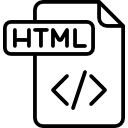HTML forms: Difference between revisions
Mr. MacKenty (talk | contribs) |
|||
| Line 10: | Line 10: | ||
[https://developer.mozilla.org/en-US/docs/Web/HTML/Element/input Click here the Mozilla documentation page with links to each input type] | [https://developer.mozilla.org/en-US/docs/Web/HTML/Element/input Click here the Mozilla documentation page with links to each input type] | ||
== Do I understand this (part 2)? == | == Do I understand this (part 2)? == | ||
Revision as of 14:11, 31 August 2022

HTML Forms[edit]
HTML Forms are one of the main points of interaction between a user and a web site or application. They allow users to send data to the web site. Most of the time that data is sent to the web server, but the web page can also intercept it to use it on its own.
An HTML Form is made of one or more widgets. Those widgets can be text fields (single line or multiline), select boxes, buttons, checkboxes, or radio buttons. Most of the time those widgets are paired with a label that describes their purpose — properly implemented labels are able to clearly instruct both sighted and blind users on what to enter into a form input.
The main difference between a HTML form and a regular HTML document is that most of the time, the data collected by the form is sent to a web server. In that case, you need to set up a web server to receive and process the data. How to set up such a server is beyond the scope of this article, but if you want to know more, see Sending form data later in the module.[2]
Click here the Mozilla documentation page with links to each input type
Do I understand this (part 2)?[edit]
If you are still stuck, or you have other questions, you may want to ask a question on our discussion board.
Do I understand this (part 3)?[edit]
If you are still stuck, or you have other questions, you may want to ask a question on our discussion board.